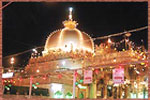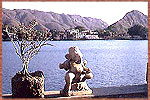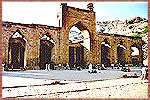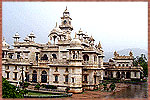Ajmer
 Ajmer is situated in the green oasis wrapped in the barren hills has been a witness to an interesting past. The city was founded by Raja Ajay Pal Chauhan in the 7th Century A.D. and continued to be a major center of the Chauhan power till 1193 A.D. when Prithviraj Chauhan lost it to Mohammed Ghauri.since then, Ajmer became home to many dynasties which came and left leaving behind indelible marks of their culture and traditions on the city’s history converting it to an amalgam of various cultures and blend of Hinduism and Islam. The city gives its name to a district and also to a former province of British India called Ajmer-Merwara which after India’s independence became the state of Ajmer until November 1, 1956 when it was merged into Rajasthan state.
Ajmer is situated in the green oasis wrapped in the barren hills has been a witness to an interesting past. The city was founded by Raja Ajay Pal Chauhan in the 7th Century A.D. and continued to be a major center of the Chauhan power till 1193 A.D. when Prithviraj Chauhan lost it to Mohammed Ghauri.since then, Ajmer became home to many dynasties which came and left leaving behind indelible marks of their culture and traditions on the city’s history converting it to an amalgam of various cultures and blend of Hinduism and Islam. The city gives its name to a district and also to a former province of British India called Ajmer-Merwara which after India’s independence became the state of Ajmer until November 1, 1956 when it was merged into Rajasthan state.
The city of Ajmer is famous as a pilgrimage site. It houses the Dargah or tomb of the popular 13th-century Sufi Saint, Hazrat Khwaja Moinuddin Hasan Chisti. Millions of pilgrims from all over the world throng Ajmer to attend the death anniversary of this great saint every year. The city also boasts of a number of monuments dating back to the Mughal era. The city is also well known for its traditional handicrafts.
The most important tourist spot in Ajmer is the Dargah or tomb of Khwaja Moinuddin Chisti. The Ana Sagar Lake and Daulat Bagh Garden are other important sites in the city. Ajmer also boasts of an imposing fort built by Akbar which also houses the Government Museum within it.Ajmer is well laid out with wide streets and handsome houses. Ajmer is at an important railway junction. The city is a trade center and has cotton mills and railroad shops. Manufactures include wool textiles, hosiery, shoes, soap, and pharmaceuticals.Ajmer is also the base for visiting Pushkar(11 km.), the abode of Lord Brahma lying to its west with a temple and a picturesque lake. The Pushkar lake is a sacred spot for Hindus. During the month of Kartik devotes throng in large numbers here to take a dip in the sacred lake.
HOW TO REACH
By Air - The nearest airport is Jaipur which is 135kms away.
By Train - Ajmer is on the Delhi-Jaipur-Marwar-Ahmedabad-Mumbai line and most trains stops at Ajmer.
By Road - It is connected with bus from all places like Jaipur, Agra, Aligarh, Abu road, Bikaner, Bharatpur, Barmer, Haridwar, Chittourgarh, Jodhpur, Jaisalmer and Nagaur.
WHEN TO GO
The best time to visit Ajmer is during the winter months from October to March.
WHAT TO SEE
 Dargah Khwaja Moin-ud-din Chisti :- The shrine is in honor of Khwaja Moinuddin Chisti – a Sufi saint who came to India from Persia in 1192 with Mohammad Ghori’s invading army. He died here in 1236. For the Muslims of India, the shrine’s importance is only second to the sacred shrine at Mecca. The construction of the Dargah was started by Altamash, the Sultan of Delhi, and completed by the Mughal Emperor Humayun. It was the venue of an annual pilgrimage for Akbar the Great.
Dargah Khwaja Moin-ud-din Chisti :- The shrine is in honor of Khwaja Moinuddin Chisti – a Sufi saint who came to India from Persia in 1192 with Mohammad Ghori’s invading army. He died here in 1236. For the Muslims of India, the shrine’s importance is only second to the sacred shrine at Mecca. The construction of the Dargah was started by Altamash, the Sultan of Delhi, and completed by the Mughal Emperor Humayun. It was the venue of an annual pilgrimage for Akbar the Great.
 Ana Sagar :- Ana Sagar is named after the ruler Anaji Chauhana, the artificial lake was built in the 12th century by constructing a dam across the river Luni. Ana Sagar also has a series of impressive white marble pavilions built by Shah Jahan in 1637.
Ana Sagar :- Ana Sagar is named after the ruler Anaji Chauhana, the artificial lake was built in the 12th century by constructing a dam across the river Luni. Ana Sagar also has a series of impressive white marble pavilions built by Shah Jahan in 1637.
 Adhai-din ka Jhonpra :- It is located on the outskirts of the town, this remarkable structure is an exquisite example of early Indo-Islamic architecture. It is designed by Abu Bakr of Herat, the mosque is believed to have been built in two and a half days and is thus named Adhai-din. According to another story the name is derived from a two and a half day fair held here every year.
Adhai-din ka Jhonpra :- It is located on the outskirts of the town, this remarkable structure is an exquisite example of early Indo-Islamic architecture. It is designed by Abu Bakr of Herat, the mosque is believed to have been built in two and a half days and is thus named Adhai-din. According to another story the name is derived from a two and a half day fair held here every year.
 Mayo College :- Mayo College is founded by the British Viceroy Lord Mayo. It is one of the finest schools in India. Mayo College is famous not just for the quality of education it imparts but for its architecture as well. It is designed by Sir Samuel Swinton Jacob, the state engineer of Jaipur. Mayo College is built of white marble, founded in 1875, as a school for Indian princes. The first pupil was the Maharaja of Alwar in Mayo College.
Mayo College :- Mayo College is founded by the British Viceroy Lord Mayo. It is one of the finest schools in India. Mayo College is famous not just for the quality of education it imparts but for its architecture as well. It is designed by Sir Samuel Swinton Jacob, the state engineer of Jaipur. Mayo College is built of white marble, founded in 1875, as a school for Indian princes. The first pupil was the Maharaja of Alwar in Mayo College.








